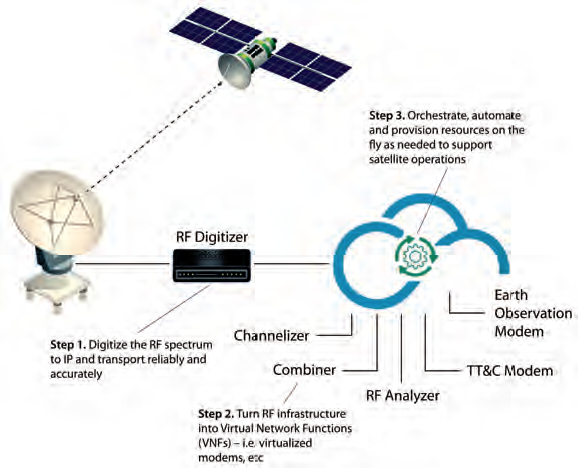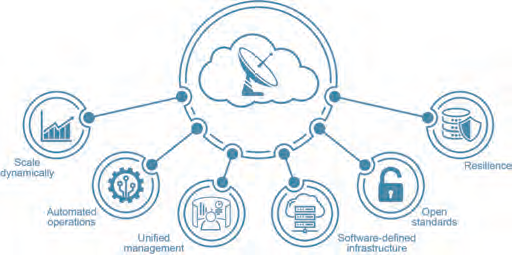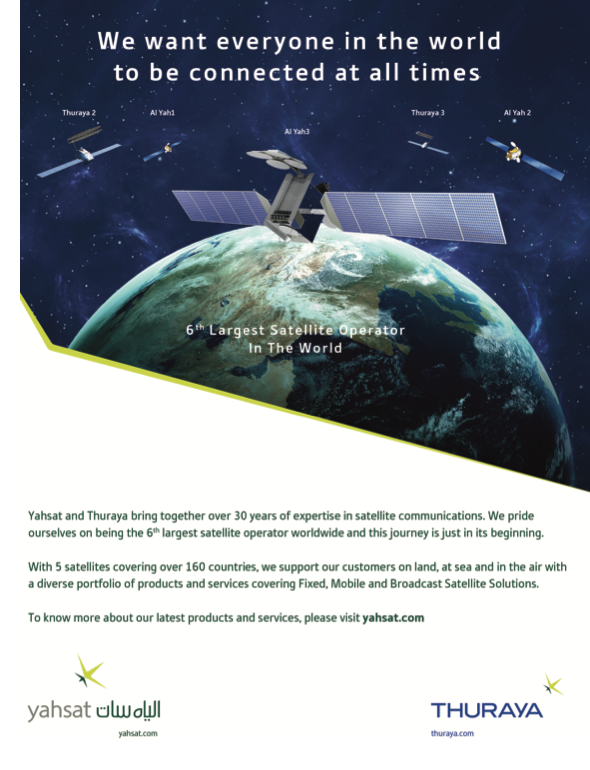The distance between satellites in orbit and systems on the ground can be measured in miles, but also technological evolution. The satellite industry is undergoing tremendous innovation and change in space. New multi-constellations and highly configurable satellites are offering the industry unprecedented increases in bandwidth and flexibility. But while these new satellites and digital payloads offer a profound step up in capability, they are also introducing far more complexity, and widening a gap between space and the ground.
 Software defined architectures are more agile, programmable, and automated, enabling the ground system to work in tandem with dynamic satellite payloads.
Software defined architectures are more agile, programmable, and automated, enabling the ground system to work in tandem with dynamic satellite payloads.
By shifting from RF signals and analog equipment to a virtualized, IP-based infrastructure, orchestration can occur on the fly.
Many of the industry’s ground systems have not kept pace with this innovation, but not out of neglect. These purpose-built hardware systems were designed for a bent-pipe, fixed satellite delivery model, sending signals up and down to relatively static payloads However, with highly configurable, reprogrammable payloads that can shape beams, changing power, capacity, and frequency on the fly, and the advent of multi constellations, this mismatch between the old and new is driving the need for equally adaptive and responsive architectures on the ground. In the future, when thousands of payloads connect millions of services to meet changing market demands, conventional ground systems that rely on point and click configuration by teams of operators will be unable to scale technologically or economically.
The Next Technological Wave
For the ground station to support this innovation in the sky, it will need to evolve from purpose-built systems intended for more static environments, to software-defined virtual systems designed for more dynamic ones. We’ll look at several key advancements that will enable this transformation. In fact, most of these innovations are proven technologies that are being used in today’s terrestrial and telecom networks, which faced their own scale and flexibility challenges. These systems migrated from static, decentralized architectures to more dynamic, efficient, and automated Software Defined Networks (SDN).
In Software Defined Networks, the underlying network infrastructure is abstracted or virtualized, running in a generic computing or cloud-based processing environment. Software-defined networks are ideal for high-bandwidth dynamic applications; they can provision, manage, and respond to demands in near real-time – doing so far faster than humans can. Similarly, the RF hardware elements that make up the traditional satellite ground segment can be replaced with a functionally equivalent family of orchestrated Virtual Network Functions (VNFs). VNFs run on the commodity compute and storage infrastructure in virtualized environments, whether in servers on-site or in a cloud platform.
Most people would consider the main benefit of shifting from racks of application-specific hardware to generic or cloud-based processing as one of cost-savings. While that is true, the key benefit of this approach is increased network flexibility and agility. By shifting from proprietary analog hardware to open virtualized software, the ground will be able to participate in an end-to-end system, linking the new software-defined assets in space to the terrestrial networks on the ground. Now they’ll be able to automatically scale and re-provision hundreds to thousands of beams and millions of services in response to changes in demand, interference, or the environment, while interconnecting far better with IP-based terrestrial networks.
The pathway to this new ground architecture involves three key components: 1) digitizing the ground system for IP compatibility, 2) replacing legacy hardware with Virtual Network Functions (VNFs), and 3) using a standardized orchestration framework to control and optimize ground operations.
Dynamic Virtualized Ground System
Step 1. Digitizing the Ground Station
This first step requires converting the analog RF signals to digital spectrum so that the waveforms can be sent as bits over IP networks for processing. This has been a problem in the past due to the inherently lossy nature of IP networks; packet loss, jitter, delay, and other network issues can alter the digitized spectrum. But now, with advances in digital IF technology, RF signals can be converted and transported securely and reliably over IP networks nearly any distance for real-time, accurate processing, without compromising the spectrum. By digitizing the satellite uplinks and downlinks links as close to the antenna as possible using an established standard such as VITA 49 for transport, the teleport’s carrier plan can be managed like a Metro Ethernet Forum-compliant (MEF) network. This allows the ground to operate more like an IP/Ethernet WAN network than a traditional analog satellite platform, connecting and integrating with cloud infrastructure and terrestrial networks for seamless end-to-end services.
Step 2. Turning Legacy Hardware to Software-based Virtual Network Functions:
With spectrum now properly digitized, the racks of analog hardware, such as splitters, combiners, and frequency converters, can be replaced with a functionally equivalent series of Virtual Network Functions (VNFs). These VNFs run on commodity computing and storage, either on-premise or offsite in the cloud. This allows the software-defined payload and the software-defined ground system to be orchestrated together as an integrated, synchronized system. As satellite payloads reconfigure, the VNFs adjust, performing digital signal processing, scaling and optimizing performance on the ground.
Benefits of a More Dynamic Ground System Software Defined Networking (SDN) and virtualized operations drive key capabilities such as scalability, automation and resilience for the ground system.
Software Defined Networking (SDN) and virtualized operations drive key capabilities such as scalability, automation and resilience for the ground system.
As VNFs are needed for specific signal processing functions, they are spun up on a baseline of generic computing cores. For example, as demand goes up and more capacity is delivered through an HTS payload, the orchestration framework provides more cores. When a cruise ship disconnects from a satcom network in port, and bandwidth goes down, the VNFs release cores. If traffic is moved due to interference, and the network goes idle, the VNFs spin down and release the cores entirely for other VNFs to leverage. This results in lower cost, more efficient networks, but more importantly enables a common pool of compute resources on the ground to scale up and down dynamically in tandem with the satellite.
With the VNFs able to process in sync with changing beams and bandwidth, operators can capitalize on these more flexible payloads to optimize throughput for customer needs. They can manage the network in real-time and shift their approach of selling bandwidth from hertz to bits, like terrestrial providers do, to maximize revenue. By allocating bandwidth and bits more efficiently, they can serve and sell more customers who pay for what they actually use, without leaving blocks of underutilized capacity, while also ensuring quality of service for those sharing the same satellite or beam. This processing flexibility can also support new OpEx business models such as Infrastructure-as-a-Service (IaaS). For example, an operator looking to launch a new mobile service or expand geographic coverage no longer needs racks of costly hardware at each site; their CapEx is limited to digitization and a minimal footprint of computing and storage. They can now build and expand their network as they grow their customers, spending incrementally for additional cloud processing, deploying VNFs in software in minutes, versus shipping and installing hardware around the world, which could take weeks or months.
Step 3. Orchestrate, Automate and Optimize Network Operations
The third, and perhaps most important element to making the virtualized ground station so dynamic and scalable, is coupling the digitized spectrum and VNFs with a standards-based orchestration framework. What were previously siloed, manual point-and-click configuration tasks can then be largely automated by the ground station controller and orchestration framework. This shifts configuration and management from people and processes to technology and automation, enabling the ground station to scale, whether to support a single software-defined HTS satellite or a multi-orbit constellation. Digital services can then flow dynamically end-to-end among satellites, ground systems, and terrestrial networks.
What makes the software-defined ground different from traditional architectures is that it uses a far more rigid separation of data, control, and management planes. The data plane is the actual traffic path for a service; the control plane providing the signaling to complete the traffic path; and the management plane providing system-level configuration and monitoring. Now, as the satellite changes frequency, increases throughput, or switches between customers, from a ship arriving in port to one now departing, the orchestration framework automates the configuration and provisioning rather than relying on manual processes.
Newfound Resilience
The ability of the virtual ground station to dynamically respond to change in demand can also be used to support best-in-class resiliency. Using the generic infrastructure at each ground station of a global network, the VNFs can orchestrate in response to failure conditions, such as rain fade, migrating critical functions from one physical location to another. Similarly, in the case of hardware failures, the orchestration framework can easily shift VNFs to other cores.
Unified Intelligent Management
It’s important to note that these software-defined architectures also provide enhanced management. For example, traditional, siloed management solutions, such as network monitoring, network service management, and carrier/interference monitoring, can be merged into a common platform to improve overall network awareness, including RF. Just as digital signals are processed for common network functions, they can be proactively analyzed to detect RF interference or degrading performance, and reconfigured to avoid those problematic blocks of spectrum.
Once the interference is cleared, the network can switch back to the previously vacated spectrum. Considering that thousands more satellites and smallsats will be added to a crowded spectrum environment, this intelligent automation can manage and head off disruptions before a cascade of service impacts occur.
While the benefits of synchronizing satellites in space with the ground are clear on one side, they also extend to the other, between the satellite ground station and terrestrial networks. Once migrated to a digital infrastructure, ground systems can operate more like today’s modern IP networks than traditional analog RF platforms, seamlessly interconnecting with telecom, wireless, and expanding 5G networks.
Benefits of a More Dynamic Ground System
Looking Ahead
While this shift in the ground model may seem radically different, it’s important to note this is not a futuristic dream; the VNF/cloud-based technology and concept of operations is in use in the terrestrial comms world, and in some satellite ground systems.
For example, LEO fleet operators and multi-use satellite ground systems that are serving the smallsat and earth observation markets have deployed and used virtual infrastructure successfully for a number of missions. They are using software-based modems, front-end processors, and digital IF capabilities to process signals more efficiently and dynamically.
The telecom industry, which is much further ahead in adoption of these software-defined, cloud-based architectures, dominates the $6 trillion global communications market. In comparison, the satellite industry currently holds less than 1% of this market, but as it transforms and similarly modernizes with these highly scalable, service-aware networks, there is huge potential to grow its share, better integrating into the global communications grid and providing additional value, especially where terrestrial networks reach their limit.
As we can see, there are many compelling benefits in shifting from legacy architectures that rely on proprietary purpose-built hardware and point and click processes to more automated, intelligent, and scalable digital infrastructure – from supporting evolving new satellite technologies and changing market demands, to enabling new business models and concepts of operation. The satellite industry is at the early stages of this transition, but as it moves ahead with digital/VNF/software-defined architectures, we can expect to see:
• Less specialized hardware and analog equipment in ground systems. • Fewer dedicated ground systems and more general-purpose gateways that can interconnect with and process many different satellite payloads. • Adoption of standards and orchestration frameworks, which will provide tighter integration with terrestrial/cloud/5G networks, and more seamless end-to-end services. • More differentiation and service capabilities, not just in orbit with highly configurable capacity, but in ground systems enablement.
As the industry takes these early steps, one thing is certain: The cost effectiveness, flexibility, and resilience of software-defined, cloud-based ground systems will play a crucial role in its future. For more information, please visit: https://www.kratosdefense.com/systems-and-platforms/space-systems/virtualized-ground-station

Greg Quiggle serves as the Vice President, Product Management at Kratos, where he oversees product strategy and ongoing lifecycle management of Kratos’ commercial product portfolio. He has spent more than 25 years conceptualizing and executing successful product and technology strategies for companies in the communications industry.
Kratos is at the forefront of enabling the movement towards a more dynamic ground by offering new and enhanced ground system products that capitalize upon the advantages of virtual and cloud-based architectures, helping lower costs, increase efficiencies, enhance security, and increase scalability in service offerings. With experience spanning 300 missions over 30 years, Kratos is a leading global provider of turnkey enterprise-grade ground segment solutions that assure operations and communications performance across satellites, signals and networks.



